Is There Erased Text in Folio 1v?
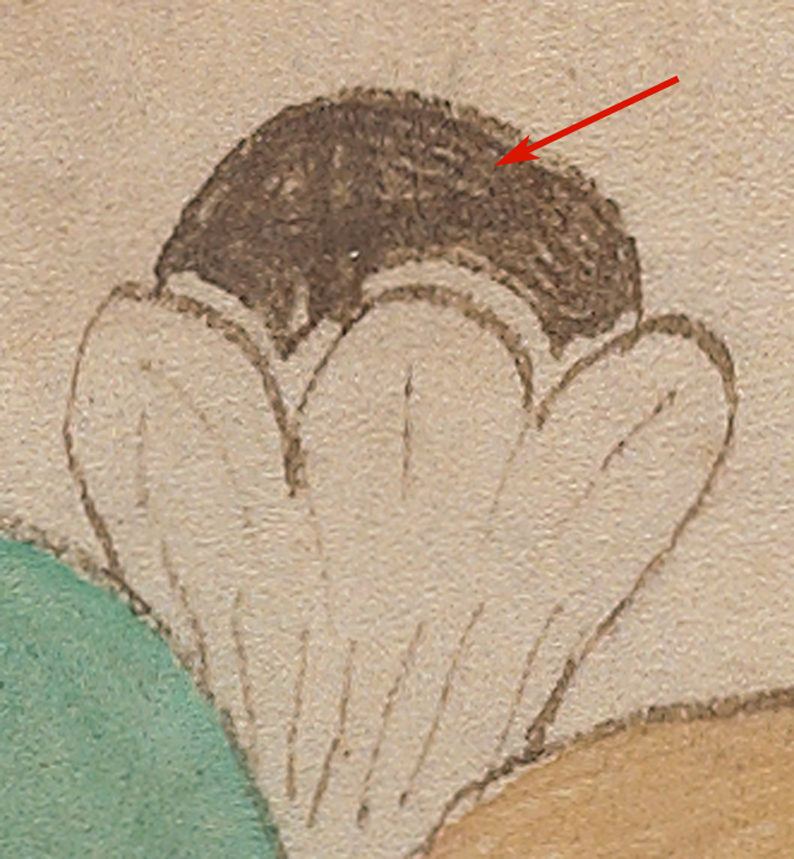 On the obverse side of Folio 1r is a plant that occupies most of the page crossed by a couple of paragraphs of text. If you look very closely, you will find some text in the fruit, in one of the green leaves, and in three of the yellowish leaves.
On the obverse side of Folio 1r is a plant that occupies most of the page crossed by a couple of paragraphs of text. If you look very closely, you will find some text in the fruit, in one of the green leaves, and in three of the yellowish leaves.
Because the bud or fruit capsule is painted brown, it’s very difficult to see what is buried there within a darker shade—it might be text or a scribble.
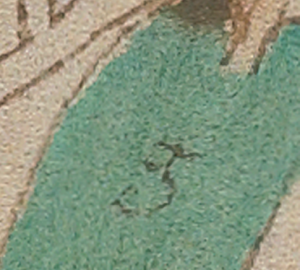 The text in the green leaf is more clear and might be an instruction to paint the plant green. The word for green is variously grøn, grön, groen, grün, gwyrdd and grien in northern Germanic languages.
The text in the green leaf is more clear and might be an instruction to paint the plant green. The word for green is variously grøn, grön, groen, grün, gwyrdd and grien in northern Germanic languages.
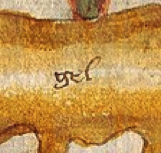 The “g” was not necessarily added by the same person who wrote the main text and it may not stand for green, but it was quite common for herbals to have initials or short words to indicate color, as in the example on the left, which is an instruction to paint the root “gel” (yellow/gold) from a Trento herbal in the Lombardic era.
The “g” was not necessarily added by the same person who wrote the main text and it may not stand for green, but it was quite common for herbals to have initials or short words to indicate color, as in the example on the left, which is an instruction to paint the root “gel” (yellow/gold) from a Trento herbal in the Lombardic era.
The fact that the “g” and “gel” were not removed before painting is also not uncommon. If you look at many old manuscripts, you will find that embellished initials were sometimes blocked out with a break in the text and an initial to show which letter to paint. After the letter was added, you can still sometimes see the original letter-instruction underneath the paint.
Getting back to the Voynich marginalia…the text in the yellowish leaves is difficult to discern and some of it looks as though it were removed before adding the plant drawing, or the marks may have resulted from pressure from something on top of Folio 1v, but it seems more likely that it was written directly on the parchment.
I’ve enlarged these elusive marks and given them slightly higher contrast so they are easier to see. The first one looks like a scribble, similar to the scribble mentioned in the previous blog. There’s a looped shape, a leaf-shaped scribble that is a slightly brownish shade, and a heart-shaped leaf that hasn’t been painted brown like the one to its left):
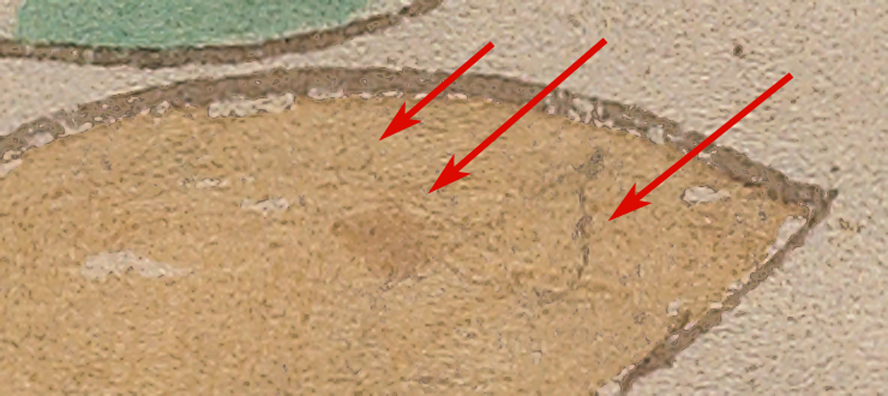 I’ve attempted to interpret the darker parts of this very light impression and it might be way off-base, but here’s one idea for what these shapes might represent:
I’ve attempted to interpret the darker parts of this very light impression and it might be way off-base, but here’s one idea for what these shapes might represent:
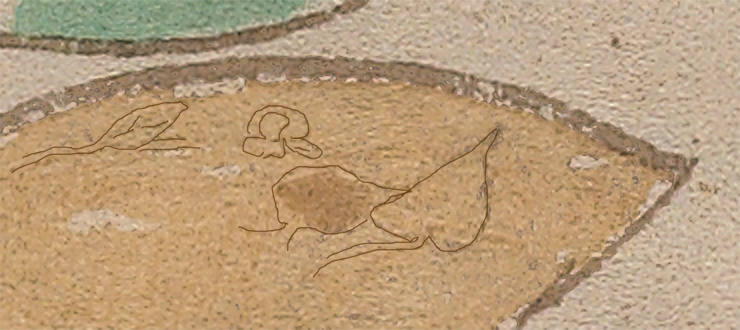 Are those tiny leaf and flower shapes? It reminds me of the small versions of plants at the end of the manuscript but these shapes are too small (and the plants at the end are mostly leaves and roots, not flowers). I think I’ll leave this on the back burner for now since there’s too little information to know if the interpretation is even close to being correct.
Are those tiny leaf and flower shapes? It reminds me of the small versions of plants at the end of the manuscript but these shapes are too small (and the plants at the end are mostly leaves and roots, not flowers). I think I’ll leave this on the back burner for now since there’s too little information to know if the interpretation is even close to being correct.
The second example resembles three lines of text that were removed before the leaf was painted. Except for the mark in the bottom right, there’s not much left except pressure marks. They might be scribbles, but they are consistent enough that they may have been text.
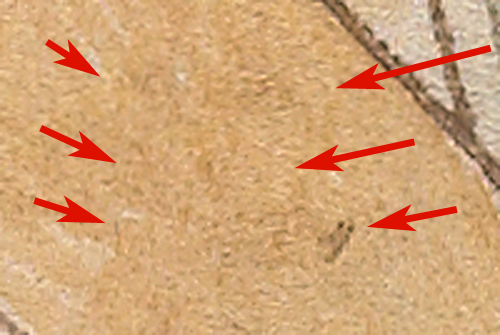 The third example, under the lower leaf, also resembles three lines of text (or possibly four if the fourth line is very short), but they don’t appear to be associated with the plant drawing or color instructions for a leaf, since the leaf margin crosses over the illegible shapes. The marks are faint, so it’s hard to tell if it’s a scribble or text, but it has a more orderly shape than most scribbles.
The third example, under the lower leaf, also resembles three lines of text (or possibly four if the fourth line is very short), but they don’t appear to be associated with the plant drawing or color instructions for a leaf, since the leaf margin crosses over the illegible shapes. The marks are faint, so it’s hard to tell if it’s a scribble or text, but it has a more orderly shape than most scribbles.
Summary
The “g” in the green leaf strongly resembles text and follows tradition if it is a painting instruction. What is interesting about the more enigmatic scribbles on Folio 86v and this last one on 1v is that they are mostly illegible and don’t have any discernible purpose related to the manuscript. Folio 86v has an unfinished T-O map in the same shade of ink as the main text on top of the scribble, and the leaf margin of Plant 1v appears to cross this one. Thus, the scribbles appear to pre-date the drawings.
Were some of these marks on parchment that was rejected by someone else and used by the VMS scribe? Was parchment graded the same way we grade clothes (with “seconds” being available at a lower price)? Or was the VMS created in an environment with a child, and did the child scribble on some of the blank parchment—marks that were later removed, perhaps imperfectly?
If the first scribble on the yellowish-beige leaf is a miniature picture of leaves, then perhaps a child witnessed the creation of the VMS plant pictures and tried to mimic them, and it’s a clue that the manuscript was created in a household rather than at a university or in a monastery. I’m leaning toward it being a secular rather than an ecclesiastical manuscript, but whether it were created in a university dorm or boarding school, in a household, or as a retirement project by a travel-weary doctor, is hard to know. Any clue adds to the existing data, even if we never entirely understand what it means.
J.K. Petersen
© Copyright 2016 J.K. Petersen, All Rights Reserved

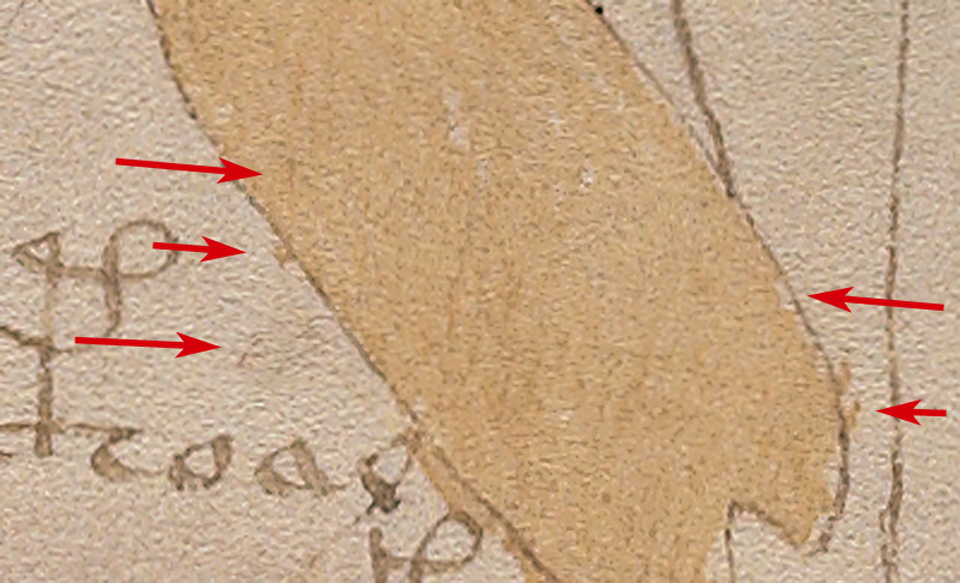
Thank you for your informative posts! It’s hard to find qualified research like this regarding the vms on the Internet. Keep up the good work!